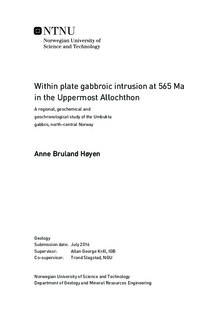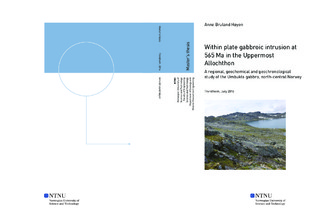| dc.description.abstract | A part of the Kjerringfjell Group in the Rӧdingsfjället Nappe Complex in the Uppermost Allochthon of north-central Norway was mapped during this thesis. The rocks in this area mainly compose of garnet-biotite gneiss, garnet-mica schist, two-mica gneiss, garnet-two mica gneiss, quartzite, pegmatite, and garnet amphibolite, and the host rock of garnet-biotite gneiss are intruded by the Umbukta gabbro and mafic dykes. The contact-zone between the gabbro and the garnet-biotite gneiss consists of contact-zone granitoid, mafic- dyke and enclaves, and granitic veins, which show evidence of mingling processes. At Umbukta and Østre Sauvatnet, mafic dykes cut the gabbro, the garnet-biotite gneiss and the quartzite.
Major- and trace element geochemical analyses were made for the Umbukta gabbro and the mafic dykes. The gabbro (represents a cumulate composition) and the mafic dykes show a tholeiitic geochemical signature. The trace element geochemistry of the rocks shows an enriched REE pattern relative to chondrite. The trace elements in the MORB normalized spider diagram mainly show an enriched pattern of the trace elements, except for Y and Yb, and the primitive mantle normalized spider diagram shows a relative enriched geochemical pattern relative to the primitive mantle, with no negative anomalies for Nb, Ta or Ti. The trace element geochemical patterns of the chondrite-, MORB-, and primitive mantle normalized spider diagrams indicate an intracontinental environment. The tectonic discrimination diagrams point to an intracontinental rift or a back-arc setting.
Geochronological analyses were conducted on the Umbukta gabbro and the host rock for age determination, with the use of the LA-ICP-MS method. The Umbukta gabbro yields a U-Pb zircon age of 565±20 Ma, and the U-Pb detrital zircon age population of the host rock mainly shows depositional ages between 1000 and 1900 Ma. The youngest age of the analysed detrital zircons was 1000 Ma, and point to depositional age younger than 1000 Ma.
The U-Pb zircon age and the geochemical signature of the Umbukta gabbro and the mafic dykes show many similarities with the gabbros in the Seiland Igneous Province (SIP), in Finnmark of northern Norway. The SIP is placed in the Kalak Nappe Complex (KNC) within the Middle Allochthon. The Umbukta gabbro could stem from the same source as the gabbros in the Seiland Igneous Province (SIP). This possible correlation should lead to a reconsideration of the interpretation of the tectonostratigraphy of the Scandinavian Caledonides. The KNC and SIP is traditionally interpreted to belong to the Middle Allochthon, and the Umbukta gabbro and mafic dykes in the Kjerringfjell Group is placed within the Uppermost Allochthon. The results of this study suggest a possible correlation of the rocks in the KNC and SIP with the rocks in the Kjerringfjell Group in the Uppermost Allochthon. | |

